
“The Wind Rises is a combination of everything that makes Studio Ghibli as we know it today. It also adds several new elements which make this film dynamic and, some say, controversial.” (Touchstone Pictures)
By Alexis Agliano Sanborn (Shimane-ken, 2009-11) for JQ magazine. Alexis is a graduate of Harvard University’s Regional Studies—East Asia (RSEA) program, and currently works as an executive assistant at Asia Society in New York City.
Written and directed by Hayao Miyazaki, The Wind Rises is like no Studio Ghibli movie I have ever seen. No. Wait. It’s like every Ghibli movie I have ever seen. You want fantasy? You got it. You want airships à la Castle in the Sky or Nausicaä of the Valley of the Wind? You got it. You want deliciously portrayed food? You want nostalgic scenery from bygone days of Tokyo or picturesque European towns? You got that, too. The Wind Rises is a combination of everything that makes Ghibli as we know it today. It also adds several new elements which make this film dynamic and, some say, controversial.
One of the most differentiating factors is that The Wind Rises is the only full-length feature to focus on an actual historical figure—Jiro Horikoshi, the designer of the Mitsubishi A5M, a fighter aircraft of World War II. Granted, Miyazaki used his artistic license to embellish the narrative—but he does that only to make things more beautiful and fantastical. (And that’s why we love Miyazaki, right?)
Watching The Wind Rises, you feel repeatedly—and indeed the entire plot more or less focuses on—Japan’s desperation to achieve modernity according to “Western standards.” But modernization was not a smooth road, and Miyazaki makes that message clear. Despite the beautiful veneer, the crux of this film lies in the frustration of a country and its people. Economic deflation, poverty, and limited resources repeatedly arise as roadblocks. (This may explain part of the reason for its amazing popularity in Japan. Frustrations, impatience and desperation exist within every generation.) Yet, as Jiro is reminded, even with setbacks and disappointments, one must live on and progress despite it all.
JQ Magazine: JQ&A with Marco Lienhard, Artistic Director of Taikoza

“I always seem to discover new things and different aspects of the music when teaching people from different backgrounds. When trying to explain some of the music, some things seem to come back to mind that were deep inside myself.” (Courtesy of Marco Lienhard)
By Rashaad Jorden (Yamagata-ken, 2008-10) for JQ magazine. A former head of the JETAA Philadelphia Sub-Chapter, Rashaad currently studies responsible tourism management at Leeds Metropolitan University. For more on his life in the UK and enthusiasm for taiko drumming, visit his blog at www.gettingpounded.wordpress.com.
Marco Lienhard has been involved in Japanese music for more than 30 years, first as a member of Ondekoza and then as the artistic director of Taikoza. When building his reputation as a professional taiko player in Japan, Lienhard also mastered the shakuhachi, eventually peforming at four major shakuhachi festivals around the world. He is also the founder of shakuhachi and koto group the East Winds Ensemble.
Lienhard has also released several albums, and his music can he heard on the score of the Nintendo Wii games Red Steel and Red Steel 2. His music has also appeared on ESPN, the History Channel and PBS. In this exclusive interview, Marco discusses his efforts to expand taiko’s global audience, the biggest influences in his career, and his personal highlights among 6,000 performances (and counting).
Where are you originally from and what sparked your interest in Japan and its traditional music?
I originally came from Switzerland, the French part. I went to Japan when I was 18 on some exchange program. I was very interested to go to Japan, but did not know much about it. Once there, I discovered the shakuhachi and the taiko. I had been studying the flute, but that sound of the shakuhachi just was amazing and I decided to study the instrument and master it. The first time I heard it was when I saw Ondekoza. There was taiko, too, and that was just so exciting to see. I did not know that I could play taiko too, but the flute seemed more approachable at the time.
I joined Ondekoza a few months later thinking I would stay just a few months, but it turned into 18 years.
For me, the sound of the shakuhachi was what drew me into it, though I fell in love with the traditional art forms as well. I enjoyed the theater as well as the music. I would go see two to three plays a month, noh or kabuki.
What drew you to taiko in the first place and to become a performer? What are the most important lessons it has taught you?
When I went to Japan, I had been studying piano and flute for many years. To become a performer was just a natural progression from studying with Ondekoza and becoming a member of the group. One thing led to another—studying with them and getting into the whole practice and running aspect of the group.
Marathon running was part of the training, and before long I was running marathons. I joined in August but by November they had me run a full marathon. My first performance was in January for the Imamiya Ebisu Festival on Dotonburi Street in Namba, Osaka. Once I started performing, I got the bug and just wanted to get better at it and study the shakuhachi as well. I was the only one who studied the shakuhachi so I was put on stage very quickly. Taiko has taught me a lot. It is sort of a college or university if not more—a life lesson.
Mr. [Tagayasu] Den, who was the founder of Ondekoza, [influenced] what taiko is now. He was a great influence in the development of modern taiko, though he never really played taiko. He was the brain and the force behind the group. He would lecture us on everything. He would turn a book into lessons for us to learn and apply to stage or performing or taiko. His vision as a director also influenced me on staging of a show
You were a professional taiko player in Japan. How does one become a professional taiko player?
While I was in Japan, I joined Ondekoza and as a member of Ondekoza I studied and later performed professionally with Ondekoza, traveling around the world to perform. At the time, Ondekoza and taiko groups were still not that popular and they did not yet have an apprenticeship system. As a member, you learned the repertoire and practiced with the regular members until you were at their level and were performing among them. It took me about four months before I had my debut on shakuhachi, and taiko drummer Den, the director of Ondekoza, is the person who would decide who was playing and what instrument.
JQ Magazine: 2013 JETAA National Conference in Minneapolis Recap
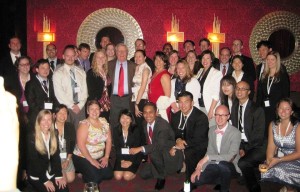
JETAA USA National Conference participants in Minneapolis with former Vice President of the United States Walter Mondale, Sept. 26, 2013. (Courtesy of Yeu-Li Huang)
By Yeu-Li Huang (Yamanashi-ken, 2007-2010) for JQ magazine. Yeu-Li is the current chapter secretary of the JET Alumni Association of the Southeast (JETAASE).
MINNEAPOLIS, Minn. – The JET Alumni Association of Minnesota (JETAAMN) hosted this year’s USA National Conference from Sept. 26-29 with assistance from the Ministry of Foreign Affairs (MOFA) and the Council of Local Authorities for International Relations (CLAIR). Attendees included delegates from all 19 JETAA USA chapters, as well as representatives from CLAIR, MOFA, and the Consulate General of Japan at Chicago.
Each national conference spotlights particular challenges facing the JETAA community. This year was no different, as critical topics included continuation of the JETAA national initiatives, common issues facing JETAA chapters, membership outreach, and collaboration between JETAA chapters and other Japan-related organizations.
Thursday, Sept. 26
The conference got underway with an evening reception at the restaurant Crave, featuring former Vice President of the United States Walter Mondale as a special guest. A native Minnesotan, Mondale was also the U.S. ambassador to Japan from 1993-96. In his speech, Mr. Mondale praised the work that the JET Program has done in building personal relationships between Japan and the U.S., and called for “JETers” to continue fostering those ties.
JQ Magazine: JQ&A with Producer Jeron Moore on ‘The Legend of Zelda: Symphony of the Goddesses’

Producer Jeron Moore on Symphony of the Goddesses: “We cater to all ages. You’ve got to remember that Zelda is 27 years old now. We’re seeing fans spanning three generations buying tickets to the show.” (Andrew Craig)
By Vlad Baranenko (Saitama-ken, 2000-02) for JQ magazine. Vlad is an avid photographer.
F. Scott Fitzgerald famously said, “There are no second acts in American lives.”
Fortunately, there are Second Quests.
Over 25 years after the blockbuster Nintendo video game series first hit the scene bearing its namesake in honor of Fitzgerald’s wife, The Legend of Zelda: Symphony of the Goddesses returns for an encore run in some of North America’s most distinguished theater halls (including, for the first time, a pair of dates in Mexico). Presented by Jason Michael Paul Productions, the show—currently on tour through December—presents the very best of Zelda’s lush symphonic scores paired with a live orchestra and visual effects.
In this JQ exclusive, producer and lead creative Jeron Moore sounds off what’s new about the show, the experience of working with Nintendo to bring the ultimate live experience to fans, and the evolution of Link throughout the saga’s rich history.
What was the inspiration for this installment of the show?
Well, if you’re a Zelda aficionado, you’ll recognize the term “Second Quest” from the New Game+ mode from the original 1986 entry, The Legend of Zelda, on the NES. It’s a mode you’d unlock once you defeated the game, and what it did was reorganize the game a little bit, made the dungeons a bit harder, made the items a bit more challenging to find, made the bosses a bit more difficult to defeat. We’ve taken the idea of visiting familiar places while encountering new challenges and applied that to the Second Quest, which has been revamped to include a half hour of new material while keeping all of the classics that make The Legend of Zelda what it is.
What surprises can we expect from the Second Quest?
They wouldn’t be surprises if I told you! But I will hint that we’re celebrating the 20th anniversary of a particular, very special handheld title. We’ve also finally included some music from one of the most recent Zelda games, which we steered cleared of with the first season program. And at the request of Mr. Eiji Aonuma, you can also expect to see a fully revamped Wind Waker segment, featuring gorgeous visuals from the game’s recent HD release on the Wii U. The Wind Waker has never looked better.
How did the idea for format of the show come about? The large screen, the orchestra?
It’s simple. There’s just nothing classier than a large orchestra tuning up, then performing powerhouse symphonic interpretations of your favorite music, no matter the genre. For The Legend of Zelda, we wanted Symphony of the Goddesses to be as accessible as possible. There’s nothing worse than sitting in a room and feeling left behind because you didn’t walk in with a prerequisite knowledge of the material. The music undoubtedly stands on its own, but incorporating visuals opens it up and informs the entire audience of context, not just those who’ve played the games before. Of course, being the fans that we are, we’ve carefully edited the footage into an entertaining narrative that, we feel, makes sense. With that, we’re able to hit on many of the important moments universally adored by fans, so yeah—lots of inside jokes, but we try not to let anything fall flat.
JQ Magazine: Australia Unfolds Its 17th Japanese Film Festival

The new Dragon Ball Z: Battle of Gods hits six cities in Australia as part of its 17th Japanese Film Festival continuing in October through December. (Dragon Ball Z Production Committee)
By Eden Law (Fukushima-ken, 2010-11). After the JET Programme more than fulfilled its promise of “an experience of a lifetime,” Eden returned to Sydney, Australia, where he joined the JETAA New South Wales chapter to take advantage of the network and connections available to undertake projects such as an uchiwa design competition for the Sydney Japan Festival. He also maintains the JETAANSW website and social media. Other than that, he’s a web designer and a poet, gentlemen and raconteur.
Like a springtime wave of hanami Down Under, the 17th Japanese Film Festival began showing in staggered releases nationally in Australia, blooming first in Broome in late September, before displaying a full bouquet of film delights in the major metropolitan areas of Sydney and Melbourne. This is the first time that the festival has launched a national program, ranging from a mini ensemble of three films for small towns like Broome and Cairns, to a behemoth 33 new films and five classics in major cities like Melbourne and Sydney, which means the festival will run from 17 Sep to 8 Dec as it tours around Australia. Many of the new films will be shown for the first time in Australia (aw, you spoil us, Japan Foundation, you really do!). In addition, at this time of writing, the five classics will be shown for free, allowing even the most penniless hipster to get a gander and drop a casual mention at the right fashionable dinner parties.
With so many new films, many of which aren’t known outside of Japan (trust me, I’ve Googled this), how will you know which to watch and be informed like the sophisticate that you no doubt are? Well, for a start, check out the screening schedules for all the films in your (nearest) city. But fret not, gentle reader, for I shall explore some of the selections on show.
Based on a True Story
Documentaries and dramatisations based on true stories feature strongly in this year’s program. A Boy Called H, which won Special Prize at the Moscow International Film Festival 2013, is based on Kappa Senoh’s best-selling autobiography about growing up in World War II-era Kobe. Closing some of the larger programs, Fruits of Faith is based on a novel inspired by a true story of a fruit grower who tries to achieve the impossible dream of the perfect crop of organic apples, despite skepticism and threat of bankruptcy. Reunion, based on a journalist’s accounts, is an illustration of how individuals strive to retain their humanity and compassion in the face of unrelenting misery and death in the wake of the Tohoku disaster. Leaving no eye dry at last year’s Montreal Film Festival, it’s a good way to see if life has yet to crush all feelings out of your bitter husk. And for anyone who has ever treasured a truly good bowl of ramen (especially after a long night of clubbing in Tokyo—the Japanese equivalent to our 4 a.m. kebab), the documentary The God of Ramen will inspire not just food lovers, but anyone who’s ever had an all-consuming (hah!) passion.
JQ Magazine: Book Review – ‘Three Scenarios in Which Hana Sasaki Grows a Tail’
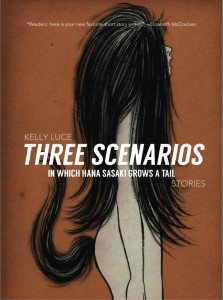
JET alum Kelly Luce’s first published collection of fiction, Three Scenarios often utilizes magic realism to tell stories that take place in Nippon. (A Strange Object)
By Rashaad Jorden (Yamagata-ken, 2008-10) for JQ magazine. A former head of the JETAA Philadelphia Sub-Chapter, Rashaad currently studies responsible tourism management at Leeds Metropolitan University. For more on his life in the UK and enthusiasm for taiko drumming, visit his blog at www.gettingpounded.wordpress.com.
As mysterious as Japan seems to be, there are numerous occurrences in the country that leave you amazed.
Enter Kelly Luce (Kawasaki/Tokushima-ken, 2002-04). The JET Program alum’s first published collection of fiction, Three Scenarios in Which Hana Sasaki Grows a Tail (which is also the title of one of Luce’s stories) often utilizes magic realism to tell stories that take place in Nippon.
Three Scenarios contains ten stories and the first one, titled “Ms. Yamada’s Toaster” (which previously appeared in the anthology Tomo), tells the tale of a toaster that can predict one’s death (the toaster even predicted the death of Ms. Yamada’s husband by popping out a piece of bread three days before he suffered a heart attack). In other stories in Three Scenarios, a teenage girl disappears during karaoke and a stone is haunted by a demon.
While there may be times in Luce’s stories that Japan may seem inconsequential, the “it could only happen in Japan” moments make her stories came alive. For example, in “The Blue Demon of Ikumi,” a foreigner woman who was considered a demon because a child died under her care is set to be executed (she eventually escapes). In “Wisher,” people make seasonal wishes at a fountain’s stone steps, such as students and parents praying before entrance exams in autumn and during summer for travel. And in the above-mentioned “Ms. Yamada’s Toaster,” some villagers wish to make the toaster a deity.
JQ Magazine – Book Review: ‘The Way of Taiko’
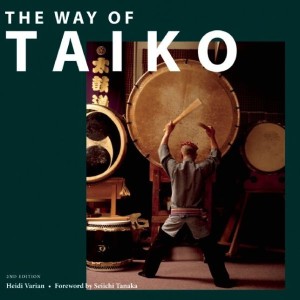
“Those who want to learn more about taiko, whether they are novices in Japanese drumming or have been playing for several years, will be amazed by the rich history and culture of the genre.” (Stone Bridge Press)
By Rashaad Jorden (Yamagata-ken, 2008-10) for JQ magazine. A former head of the JETAA Philadelphia Sub-Chapter, Rashaad currently studies responsible tourism management at Leeds Metropolitan University. For more on his life in the UK and enthusiasm for taiko drumming, visit his blog at www.gettingpounded.wordpress.com.
Many JETs—myself included—have been drawn to taiko because we love the sound emanating from the drums and want to partake in something traditionally Japanese. But what do we really know about taiko?
For those looking to expand their knowledge of Japanese drumming, Heidi Varian’s The Way of Taiko (now available in a new edition from Stone Bridge Press) is a great way to go. Varian, a member of the San Francisco Taiko Dojo, introduces readers to the history and contemporary culture of the music that is a symbol of Japan to many.
Varian calls taiko the “heartbeat of Japan,” and that’s appropriate because the drum was a method of gathering townspeople or letting them know about any impending danger, in addition to being used to celebrate festivals. Like seemingly everything that’s considered an integral part of Japan, taiko has an enormously long history clouded in mystery (it actually may not have originated in Japan), but Varian explores it.
She not only examines taiko’s beginning and its importance in ancient Japan, but how taiko appeared in traditional Japanese theatrical forms like noh and kabuki. She also writes about how taiko gained a foothold in the United States—the first documented taiko drum appeared in San Francisco in 1910—and its pioneers (such as Seiichi Tanaka and Kenny Endo) on this side of the Pacific. Varian also doesn’t also live in the past when talking about taiko, as she raises important issues about its future.
JQ Magazine Seeks Writers for Fall 2013!
As we head into fall, JETAA New York’s JQ magazine continues to provide content with an ever-expanding array of articles, interviews and features (see our recent stories here). We’re now looking for new writers, including recent returnees and JET vets, from all JETAA chapters worldwide for posting stories via our host at the global JET alumni resource site JETwit.com. (Scribes are also encouraged to join the JET Alumni Writers group on LinkedIn.)
Below are story ideas grouped by JET participants and alumni (JET World) and those more on Japanese culture (Japan World). And if you’re a JET or JETWit contributor from anywhere in the world with a story idea of your own, let us know!
Click “Read More” below for our fall 2013 ideas pitch package, and contact JQ editor Justin Tedaldi (magazine [at] jetaany [dot] org) to sign up for stories.
Now, JQ is looking for additional help behind the scenes! Our editor (celebrating his fifth anniversary at the helm in November) is seeking a capable assistant to help with the posting, social media sharing and story assigning across all JETAA chapters. If you’re a wiz with WordPress, Facebook and Twitter, and enjoy all forms of Japanese arts, events and media, reach out to Justin. Thanks and yoroshiku!
JQ Magazine: JQ&A with Tom Byer on Life in Soccer, Japan

“I believe we may see Japan win a World Cup within my lifetime, and I certainly think they will be the first Asian team to do so. They are the type of team that the current world powers would not like to have in their group during a WC tournament.” (Courtesy of K.K. T3)
By Lyle Sylvander (Yokohama-shi, 2001-02) for JQ magazine. Lyle has completed a master’s program at the School of International and Public Affairs at Columbia University and has been writing for the JET Alumni Association of New York since 2004. He is also the goalkeeper for FC Japan, a New York City-based soccer team.
Tom Byer (a.k.a. Tomsan) is an American soccer coach who has lived in Japan for nearly 30 years. The first professional American soccer player in Asia, he has been a major figure in Japan as a coach and educator. In fact, many people in Japan see him as a major catalyst behind the country’s rising status as a global soccer power. Byer is responsible for increasing soccer’s popularity and teaching fundamental skills to hundreds of thousands of children, including many of the nation’s most celebrated players. In the process, he has become a well-known media personality and has even extended his influence to China, where he signed a contract with the Chinese Football Association to be a technical director for youth teams.
Where are you from? Was soccer popular there when you were growing up?
I was born in the Bronx, New York City. I grew up in Rosendale, Ulster County, Upstate New York. Soccer was just becoming popular when I was a kid. I first started playing baseball and changed over to soccer after my brother and his friends started to play. But soccer was still a very minor sport.
How did you end up living and working in Japan?
I was introduced to Hitachi FC, which is currently playing in the J-League as Kashiwa Reysol, back in 1986 because my college coach at Ulster County Community College had some connections here. So I had a short stint with them, which gave me experience in Japanese soccer. And when I hung up the playing boots I decided to get into youth development. I also did many things on the U.S. military bases for kids playing soccer.
Can you tell us about your company T3, which aims to educate Japanese schoolchildren about soccer?
My company is called T3—the T stands for “Tom” and the 3 for “san,” Tomsan, because I am known by Tom-san throughout Japan from my appearances on daily television for 13 years. The name of the TV corner was, “Tom-san’s Soccer Techniques.” We try to help every child we come in contact with to “realize their potential.” We are technical specialists helping kids, coaches and parents understand the importance of developing technique. I have performed over 2,000 events for more than 500,000 people over the years. I established another company which I headed up for 16 years which established over 100 soccer schools throughout Japan. It’s difficult to find almost any player in Japan today who hasn’t been influenced in some way regarding our activities. This means either they’ve grown up watching my daily TV corner, read the monthly KoroKoro Komikku manga, or have played in one of our 100 schools, camps, or bought our DVDs or books.
JQ Magazine: Book Review – ‘Gadget Girl: The Art of Being Invisible’
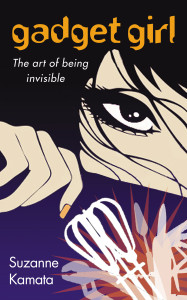
“As Gadget Girl is geared toward young adults (or more specifically, teenage girls), it is an easy read. But you get the sense that because of its diverse set of characters, it would make a good TV drama.” (GemmaMedia)
By Rashaad Jorden (Yamagata-ken, 2008-2010) for JQ magazine. Rashaad worked at four elementary schools and three junior high schools on JET, and taught a weekly conversion class in Haguro (his village) to adults. He completed the Tokyo Marathon in 2010, and was also a member of a taiko group in Haguro.
Sometimes, we’re just trying to find out where we belong.
That’s certainly the case with Aiko Cassidy, the teenage protagonist of JET Program alum Suzanne Kamata (Tokushima-ken, 1988-1990)’s latest novel, Gadget Girl: The Art of Being Invisible. The 15-year-old daughter of a renowned sculptor, Aiko wants to develop her own identity, instead of being known as Laina Cassidy’s muse and suffering from a disability (cerebral palsy). Aiko has been secretly working on manga titled Gadget Girl, and she dreams of becoming a world famous manga artist—which would enable her to visit her father in Japan.
But instead of heading to the Land of the Rising Sun, Aiko is off to France for several days, as Laina has won the grand prize at the prestigious Prix de Paris. Although she’s still receiving the “Laina Cassidy’s muse” treatment, the City of Light does open up a new world for Aiko. For one, she develops a crush on a waiter named Hervé at the café she frequents. Aiko is also introduced to the spot where he parents met but more importantly, she learns the reason why her father is absent from her life.
Inspired by the movie The Song of Bernadette, Aiko and Laina head to Lourdes, where Aiko dreams of being cured. Instead, she hears a woman whisper “Forgive,” and Aiko uses that as a call to repair broken relationships in her life.
JQ Magazine: Book Review – ‘The Accidental Office Lady: An American Woman in Corporate Japan’
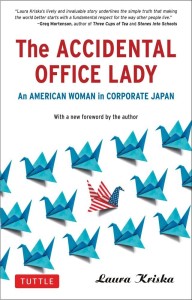
“If you are going to Japan soon, live there now, or have lived there already, this book is a survivor’s guide and tool for reflection and growth. It can help the reader better understand what to do, and what not to do.” (Tuttle)
By Lana Kitcher (Yamanashi-ken, 2010-12) for JQ magazine. Lana is the business development associate for Bridges to Japan and enjoys working as a freelance writer for a number of online publications. To read more about Lana’s adventures in Japan, visit her blog at Kitcher’s Café.
Laura Kriska’s experience as recounted in The Accidental Office Lady parallels in many ways what we as JET participants go through when we temporarily leave our lives and routines at home to pursue the “exotic” and uncertain terrain of a new culture.
Based on Kriska’s background and education, she was offered a two-year position at Honda Motor Company headquarters in Tokyo, being the first American woman to do so. She arrived in Japan equipped with her new business attire and a mind full of expectations and dreams about how the next two years of her life in Tokyo would unfold. She was soon instructed to join the secretariat—coordinating schedules and serving tea to managers in her new, polyester uniform.
Through the course of the book we get to see Kriska transform from a newly minted grad into a successful member of Japanese society. She starts out frustrated by her new environment and deeply disappointed that her job is not all that she hoped it would be. As the book progresses, you start to see that she is losing her childish tendencies to fight back, and eloquently navigating the culture with words and mannerisms instead of outbursts and small rebellions. She takes on more responsibility and in the end is able to create lasting change at Honda with a new employee manual in English and the elimination of the mandatory uniform rule.
JQ Magazine: DVD Review – ‘From Up on Poppy Hill’

“Studio Ghibli films are known for their fantastical animation and surrealistic landscapes. However, Poppy Hill lacks one other crucial element common to Ghibili films: an emotional depth of feeling.” (GKIDS)
By Lyle Sylvander (Yokohama-shi, 2001-02) for JQ magazine. Lyle is entering a master’s program at the School of International and Public Affairs at Columbia University (MIA 2013) and has been writing for the JET Alumni Association since 2004. He is also the goalkeeper for FC Japan, a New York City-based soccer team.
From Up on Poppy Hill is the latest film to be released from Japan’s famed Studio Ghibli. Unlike its more prominent titles, this one is not directed by studio founder Hayao Miyazaki (Spirited Away, Howl’s Moving Castle) but rather by his son Goro Miyazaki. The father did, however, co-write the script (with Keiko Niwa), which was adapted from a manga published in the 1980s. Goro’s first film, Tales from Earthsea, was a commercial hit but received a very negative reception, even receiving “Worst Director” and “Worst Picture” designations from the Bunshun Raspberry Awards, given annually to the worst in cinema by the Bungeishunju Publishing Company. From Up on Poppy Hill received a much better reception (although many reviews were mixed) and became the highest grossing Japanese film of 2011 and won the 2012 Japan Academy Prize for Animation of the Year.
The story takes place in Yokohama in 1963, a pivotal point in Japan’s history as the country was preparing for the 1964 Tokyo Olympics. The nation was on the economic upswing and the Olympics were meant to showcase the “new” Japan as it pushed its postwar ruin firmly into the past. Within this context, Poppy Hill tells two stories, both of which deal with historical consciousness. The first concerns a high school student named Umi, who lives and works in her family’s boarding house. Her father was lost at sea during the Korean War and Umi flies nautical flags daily from her house in order to wish peace upon all sailors. The second story concerns a clubhouse (named the Latin Quarter), which has been slated for demolition to make way for an Olympics-related building. The building is adjacent to Umi’s high school and she meets Shun, the leader of the clubhouse, who also happens to have been decoding her nautical flags each morning. Umi leads an effort to clean up the clubhouse and soon starts to fall in love with Shun.
JQ Magazine: Book Review – ‘Pink Globalization: Hello Kitty’s Trek Across the Pacific’
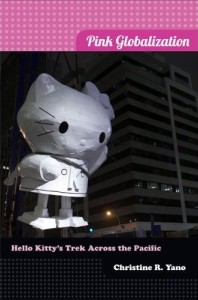
“Pink Globalization is a culmination of over ten years of Yano’s fieldwork and research on the international ubiquity of Hello Kitty as an example of Japan’s actions as a tastemaker in global kawaii.” (Duke University Press)
By Jessica Sattell (Fukuoka-ken, 2007-08) for JQ magazine. Jessica is a freelance writer and a graduate student in arts journalism. She readily admits that while she is an avid Hello Kitty fan, she is always going to like Chococat more.
For many, young and old, female and male, Hello Kitty (or Kitty-chan, as her diehard fans lovingly call her) has been a lifelong friend. As I toted around my review copy of the new Pink Globalization: Hello Kitty’s Trek Across the Pacific—to my part-time job, to coffee shops, on a recent trip—strangers cooed over the cover’s soft pink color scheme and photograph of one of artist Tom Sachs’s renditions of the famous feline. Kitty led the way into my very first experiences with Japan, and her ever-presence has enriched my life in ways that I didn’t fully understand until diving in to Christine R. Yano’s research.
The wide-eyed little cat has been Japan’s acting ambassador for decades, and her global travels had (and continue to have) profound impacts on generations of consumers and culture shapers. Pink Globalization is a culmination of over ten years of Yano’s fieldwork and research on the international ubiquity of Hello Kitty as an example of Japan’s actions as a tastemaker in global kawaii.
Yano, who is Professor and Chair of Anthropology at the University of Hawai‘i at Manoa, explains that Kitty’s rise, development and continuing presence as perpetuated by both parent company Sanrio and an ever-growing fandom provides a rich text from which to examine a multitude of contemporary issues. Yano coins the term “pink globalization” here to refer to the spread of “cute” goods and images from Japan to other parts of the world, and it connects the actions of global capitalism with Japan’s “coolness” in its soft cultural products.
JQ Magazine: Film Review – ‘Cutie and the Boxer’ Pairs Sparring Partners in Life, Art
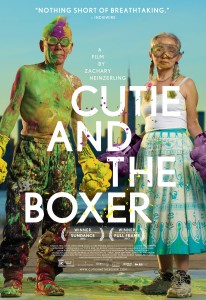
“Director Zachary Heinzerling spent five years with the Shinoharas in the making of his movie, and it has been recognized with critical praise and honors including the U.S. Documentary Directing Award at this year’s Sundance Film Festival.” (RADiUS-TWC)
By Stacy Smith (Kumamoto-ken CIR, 2000-03) for JQ magazine. Stacy is a professional Japanese writer/interpreter/translator. She starts her day by watching Fujisankei’s newscast in Japanese, and shares some of the interesting tidbits and trends together with her own observations in the periodic series WITLife.
Director Zachary Heinzerling’s debut documentary is the captivating Cutie and the Boxer, which follows two New York-based Japanese artists who have been married for over 40 years. It stars Ushio and Noriko Shinohara, a couple separated in age by two decades who have a truly unique union. They alternately bicker and support each other, but you get the sense that their respective existences are necessary for the other to survive. As wife Noriko puts it, “We are like two flowers in one pot,” meaning that when things are going well they are essential for each other’s flourishing, but when things are not they are fighting over limited space and nourishment.
Ushio (a.k.a. Gyu-chan) is an artist who was active in the avant-garde art movement, and is known for his boxing paintings and motorcycle sculptures. He achieved great fame in Tokyo before moving to New York to test his skills in the States. He was 40 at the time he met Noriko, who was 19 and had come to New York to study art. Things happened quickly between them, and soon they were married with a son, Alex. Noriko put aside her artistic aspirations to help Ushio in his career and raise Alex, thus curbing the potential for her own success.
Meanwhile, Ushio was floundering in building a name for himself as an artist in his new country. Despite the fact that he had become a father, he didn’t want to move beyond his old ways of drinking with friends and discussing philosophies regarding art. One of the most poignant and candid scenes in the film is when Ushio becomes quite drunk at one of these gatherings and emotionally describes both the pain and sublime pleasure he receives from creating art, saying that he would rather die than do anything else with this life. It is one of the film’s truly heartbreaking and inspiring moments.
JQ Magazine: Book Review — ‘Yokohama Yankee’

“Yokohama Yankee shows how the events that precede us—the social and political movements, wars, technological advances, and natural disasters—inform our attitudes and behaviors.” (Chin Music Press)
By Michael Glumac (Miyazaki-ken, 2008-09) for JQ magazine. Michael is currently enrolled as a graduate student in international affairs, and has been a music publicist and artist manager.
Pages of Leslie Helm‘s new book Yokohama Yankee seem as though they might be perfectly at place in a Dan Brown novel, and this I mean in the most complimentary manner possible.
Really.
Helm’s non-fiction account of his family’s five generations as outsiders in Japan possess none of the mixed metaphors or historical incongruence so mocked in the Da Vinci Code author’s oeuvre. Portions of Yokohama Yankee, though, where Helm explores remote regions of Japan to uncover the story of his ancestors, possess genuine intrigue surpassing any poorly imagined scuffle with murderous druids.
In an effort to learn about his German great-great-grandfather Julius’s Japanese wife (who once stopped a sword with her bare hands), Helm enlists the help of Buddhist priests to pore over a mountain village temple’s old rice paper scrolls. From the ruins of a Roman aqueduct-like bridge, Helm identifies a mysterious abandoned island off the coast of Kyushu. Here his father engaged in a post-World War II love affair with a woman who had rumored royal connections. His exploration concludes:
“On the way back to the boat we came upon a stone monument about twelve feet high that was all but hidden by shrubs. I held the branches back while the director read the inscription carved into the stone: ‘This is to memorialize the visit of his highness…of the Imperial family.’ The aquarium director looked at me with excitement.”
Feat not, the aquarium director doesn’t turn out to be working for a secret sect of Opus Dei.


